Flexural Behavior of UHPC Beams Prestressed with External CFRP Tendons
Abstract
:1. Introduction
2. Experimental Program
2.1. Details of Specimens
2.2. Material Properties
2.2.1. CFRP Tendons
2.2.2. UHPC
2.3. Tensioning Procedure, Loading Methods, and Measurements
3. Test Phenomena and Results
3.1. Failure Modes
3.2. Load-Deflection Behavior
3.2.1. The Fully Prestressed Specimens
- (1)
- The first stage was up to the flexural cracking point, and represented the stiffness of uncracked beam section. As the applied load increased, the flexural crack appeared at the bottom of the midspan section, where the tensile strain exceeded the cracking strain of the UHPC matrix. The cracking load corresponded to the tensile strength of UHPC matrix. Due to the steel fibers across the crack and the application of CFRP tendons, the stiffness of the fully prestressed specimen did not decrease immediately after the initial cracking state.
- (2)
- The second stage was from the flexural cracking point to the softening point. Because the crack surfaces were bridged by closely spaced steel fibers, the flexural cracks propagated sightly during this stage. However, the steel fibers at the crack region gradually exhausted their crack-bridging effect with the increasing load, and thus the softening load was obtained when the strain in the most extreme fiber in tension reached the ultimate tensile strain of UHPC (approximately 7000 με [12]). Compared with the corresponding cracking loads, the softening loads of the fully prestressed specimens increased by 5.3% (E30-P100-D0-L3) to 29.6% (E45-P100-D0-L4). This could be attributed to the crack-bridging effect of steel fibers in the tension zone.
- (3)
- The third stage was from the softening point to the ultimate point. The applied load was almost constant with a rapid increasing deflection in this stage, until the brittle fracture of the specimen occurred. It indicated that the failure mode of the fully prestressed beams was a tension-controlled failure. The stress in the most extreme fiber in compression continued to increase, and the tendon stress also exhibited a continuous growth trend with increasing midspan deflection. Nevertheless, the losing tension force due to the reduction of the UHPC tension zone was significant, and thus the increased prestressing stress in the CFRP tendons were not sufficient to increase the applied load of the specimen [31]. As a result, the average value of Pu/Pcr of four fully prestressed beams were around 1.20. The load-transfer mechanism of the fully prestressed specimens in this stage was consistent with a tied-arch, and the external tendons acted as a tie rod.
3.2.2. The Partially Prestressed Specimens
- (1)
- The first stage was similar to that of the fully prestressed beams.
- (2)
- The middle stage was from the flexural cracking state to the yielding of the steel bars. The longitudinal steel bars could provide a high tensile force, resulting in a distributed cracking pattern on the specimens. Hence, the postcracking flexural stiffness of the specimen with internal steel bars was greatly improved. Compared to the corresponding cracking loads, the yielding loads of the partially prestressed specimens increased by 59.4% (E55-P68-D0-L3) to 66.3% (E30-P85-D3-L3). This result suggested that the postcracking flexural stiffness of the specimen with internal steel bars was significantly improved.
- (3)
- The final stage was from the yielding of the steel bars to the crushing of compressive flange. The midspan deflection of increased rapidly with the increasing applied load in this stage after the yielding of tensile bars. Moreover, compared to the fully prestressed beam E55-P100-D0-L3, the ultimate load and deflection of E55-P68-D0-L3 increased by 95.2% and 18.1%, respectively. Similarly, compared to E30-P100-D0-L3, the ultimate load and deflection of E30-P85-D0-L3 increased by 102.9% and 42.8%. The average value of Pu/Pcr of four partially prestressed beams were around 2.21. These results indicated that the addition of internal tensile bars significantly enhanced the flexural behavior of UHPC beams prestressed with external CFRP tendons.
3.3. Crack Patterns
3.4. Stress Variation in CFRP Tendons
3.5. Deformability Index
4. Analytical Investigation
4.1. Stress–Strain Relationships of Materials
4.2. Determination of Stress Increment in CFRP Tendons
4.3. Determination of Ultimate Moment
5. Discussion
5.1. Effect of Effective Prestressing Stress
5.2. Effect of Partial Prestressing Ratio
5.3. Effect of Deviated Angle
5.4. Effect of Loading Condition
6. Conclusions
- (1)
- The average value of energy-based deformability indexes of the specimens in the present study reached around 2.3. Hence, the application of UHPC significantly improved the deformability of FRP prestressed beams, which would benefit to structural safety.
- (2)
- The fully prestressed beams without internal steel showed a brittle failure pattern. The ultimate load of these beams was mainly controlled by the ultimate stress in CFRP tendons and the ultimate tensile strength of UHPC. By contrast, the partially prestressed beams, in which tensile steel bars were provided, failed in a ductile manner with greatly improved postcracking flexural capacity and deformability. The internal reinforcements, instead of steel fibers in UHPC, mainly affected the crack distribution and failure mode of specimens. Thus, the internal reinforcements should not be omitted from the prestressed UHPC beams with FRP tendons.
- (3)
- The flexural cracks were concentrated at one or a few locations in fully prestressed beams, whereas cracks were well distributed in the partially prestressed beams. The partially prestressed beams with a lower PPR (a smaller internal steel ratio) showed enhanced cracking resistance, flexural capacity, and deformability.
- (4)
- A higher effective prestressing stress in CFRP tendons was favorable for enhancing the cracking resistance and ultimate capacity. CFRP tendons with an effective prestressing stress of 0.55ffp or a deviated angle of 6° remained intact after bending tests, indicating a good flexural-tension performance of external CFRP prestressing system.
- (5)
- The draped CFRP tendon showed higher ultimate stress than the horizontal tendon, and thus increased the prestressing effectiveness of CFRP tendons. However, compared to that of three-point loading, the condition of four-point loading exerted a slight influence on ultimate moment and deformation.
- (6)
- A prediction method was proposed, which take into account the influence of steel fibers on the postcracking behavior. This method could appropriately predict the flexural capacity of UHPC beams prestressed with external CFRP tendons.
Author Contributions
Funding
Institutional Review Board Statement
Informed Consent Statement
Data Availability Statement
Acknowledgments
Conflicts of Interest
References
- Aparicio, A.C.; Ramos, G.; Casas, J.R. Testing of externally prestressed concrete beams. Eng. Struct. 2002, 24, 73–84. [Google Scholar] [CrossRef]
- Hartt, W.H.; Lee, S.K. Projecting corrosion-induced bridge tendon failure resulting from deficient grout: Part I–Model development and example results. Corrosion 2016, 72, 991–998. [Google Scholar] [CrossRef]
- Hackl, J.; Kohler, J. Reliability assessment of deteriorating reinforced concrete structures by representing the coupled effect of corrosion initiation and progression by Bayesian networks. Struct. Saf. 2016, 62, 12–23. [Google Scholar] [CrossRef]
- Yoo, C.-H.; Park, Y.C.; Kim, H.-K. Modeling corrosion progress of steel wires in external tendons. J. Bridg. Eng. 2018, 23, 04018098. [Google Scholar] [CrossRef]
- Guo, T.; Sause, R.; Frangopol, D.M.; Li, A. Time-dependent reliability of PSC box-girder bridge considering creep, shrinkage, and corrosion. J. Bridg. Eng. 2011, 16, 29–43. [Google Scholar] [CrossRef]
- Fang, Y.; Fang, Z.; Jiang, R.; Jiang, Z.; Zhu, D. Effect of temperature on the transverse impact performance of preloaded CFRP wire. Compos. Struct. 2020, 231, 111464. [Google Scholar] [CrossRef]
- Fang, Y.; Fang, Z.; Huang, D.; Jiang, Z.; Zhou, X. Experimental investigation on mechanical performance of carbon fiber reinforced polymer wire after exposure to elevated temperature. Compos. Struct. 2021, 274, 114388. [Google Scholar] [CrossRef]
- Terrasi, G.P.; Bisby, L.; Barbezat, M.; Affolter, C.; Hugi, E. Fire Behavior of Thin CFRP pretensioned high-strength concrete slabs. J. Compos. Constr. 2012, 16, 381–394. [Google Scholar] [CrossRef]
- Au, F.T.; Du, J. Deformability of concrete beams with unbonded FRP tendons. Eng. Struct. 2008, 30, 3764–3770. [Google Scholar] [CrossRef]
- Kahanji, C.; Ali, F.; Nadjai, A. Structural performance of ultra-high-performance fiber-reinforced concrete beams. Struct. Concr. 2017, 18, 249–258. [Google Scholar] [CrossRef]
- Yang, I.H.; Joh, C.; Kim, B.-S. Structural behavior of ultra high performance concrete beams subjected to bending. Eng. Struct. 2010, 32, 3478–3487. [Google Scholar] [CrossRef]
- Yoo, D.-Y.; Yoon, Y.-S. Structural performance of ultra-high-performance concrete beams with different steel fibers. Eng. Struct. 2015, 102, 409–423. [Google Scholar] [CrossRef]
- Kang, S.-T.; Kim, J.-K. Investigation on the flexural behavior of UHPCC considering the effect of fiber orientation distribution. Constr. Build. Mater. 2012, 28, 57–65. [Google Scholar] [CrossRef]
- Zhu, H.; Cheng, S.; Gao, D.; Neaz, S.M.; Li, C. Flexural behavior of partially fiber-reinforced high-strength concrete beams reinforced with FRP bars. Constr. Build. Mater. 2018, 161, 587–597. [Google Scholar] [CrossRef]
- Yoo, D.-Y.; Banthia, N.; Yoon, Y.-S. Predicting service deflection of ultra-high-performance fiber-reinforced concrete beams reinforced with GFRP bars. Compos. Part B Eng. 2016, 99, 381–397. [Google Scholar] [CrossRef]
- Shafieifar, M.; Farzad, M.; Azizinamini, A. A comparison of existing analytical methods to predict the flexural capacity of Ultra High Performance Concrete (UHPC) beams. Constr. Build. Mater. 2018, 172, 10–18. [Google Scholar] [CrossRef]
- ACI Committee. Building Code Requirements for Structural Concrete ACI 318-14; American Concrete Institute Committee 318: Farmington Hills, MI, USA, 2014. [Google Scholar]
- ACI Committee. Design Considerations for Steel Fiber Reinforced Concrete ACI 544.4R-1988 (R2009); American Concrete Institute Committee 544: Farmington Hills, MI, USA, 2014. [Google Scholar]
- FHWA. Design Guide for Precast UHPC Waffle Deck Panel System, Including Connections FHWA-HIF-13-032; Federal Highway Administration: Washington, DC, USA, 2013. [Google Scholar]
- Grace, N.F.; Abdei-Sayed, G. Behavior of externally draped CFRP tendons in prestressed concrete bridges. PCI J. 1998, 43, 88–101. [Google Scholar] [CrossRef]
- Atutis, M.; Valivonis, J.; Atutis, E. Analysis of serviceability limit state of GFRP prestressed concrete beams. Compos. Struct. 2015, 134, 450–459. [Google Scholar] [CrossRef]
- Atutis, M.; Valivonis, J.; Atutis, E. Deflection determination method for BFRP prestressed concrete beams under fatigue loading. Compos. Struct. 2019, 226, 111182. [Google Scholar] [CrossRef]
- Atutis, M.; Valivonis, J.; Atutis, E. Experimental study of concrete beams prestressed with basalt fiber reinforced polymers. Part I: Flexural behavior and serviceability. Compos. Struct. 2018, 183, 114–123. [Google Scholar] [CrossRef]
- Tran, D.T.; Pham, T.M.; Hao, H.; Chen, W. Numerical study on bending response of precast segmental concrete beams externally prestressed with FRP tendons. Eng. Struct. 2021, 241, 112423. [Google Scholar] [CrossRef]
- Ghallab, A.; Beeby, A.W. Factors affecting the external tendon stress in externally strengthened prestressed concrete beams. Cem. Concr. Compos. 2005, 27, 945–957. [Google Scholar] [CrossRef]
- Wang, X.; Shi, J.; Wu, G.; Yang, L.; Wu, Z. Effectiveness of basalt FRP tendons for strengthening of RC beams through the external prestressing technique. Eng. Struct. 2015, 101, 34–44. [Google Scholar] [CrossRef]
- Fang, Z.; Huang, Z.M.; Jia, L. Experimental research on flexural behavior of RPC beams prestressed with external CFRP tendons. J. Hunan Uni. (Nat. Sci.) 2021, 48, 103–112. [Google Scholar]
- Xiang, Y.; Fang, Z.; Wang, C.; Zhang, Y.; Fang, Y. Experimental investigations on impact behavior of CFRP cables under pretension. J. Compos. Constr. 2017, 21, 04016087. [Google Scholar] [CrossRef]
- Xiang, Y.; Fang, Z.; Fang, Y. Single and multiple impact behavior of CFRP cables under pretension. Constr. Build. Mater. 2017, 140, 521–533. [Google Scholar] [CrossRef]
- Yang, J.; Fang, Z.; Dai, G.L. Flexural behavior of prestressed UHPC beams. Adv. Mater. Res. 2011, 243, 1145–1155. [Google Scholar] [CrossRef]
- Dogu, M.; Menkulasi, F. A flexural design methodology for UHPC beams post-tensioned with unbonded tendons. Eng. Struct. 2020, 207, 110193. [Google Scholar] [CrossRef]
- Tan, K.H.; Ng, C.K. Effects of deviators and tendon configuration on behavior of externally prestressed beams. ACI Struct. J. 1997, 94, 13–21. [Google Scholar]
- Naaman, A.E.; Jeong, M. Structural ductility of concrete beams prestressed with FRP. In Non-Metallic (FRP) Reinforcement for Concrete Structures, Proceedings of the 2nd International RILEM Symposium (FRPRCS-2); CRC Press: Ghent, Belgium, 1995; pp. 379–386. [Google Scholar]
- Lou, T.; Lopes, S.M.; Lopes, A.V. Numerical analysis of behaviour of concrete beams with external FRP tendons. Constr. Build. Mater. 2012, 35, 970–978. [Google Scholar] [CrossRef]
- Lok, T.-S.; Pei, J.-S. Flexural behavior of steel fiber reinforced concrete. J. Mater. Civ. Eng. 1998, 10, 86–97. [Google Scholar] [CrossRef]
- Graybeal, B.A. Characterization of the Behavior of Ultra-High Performance Concrete. Ph.D. Thesis, University of Maryland, College Park, MD, USA, 2005. [Google Scholar]
- AFGC-SETRA. Ultra-High Performance Fibre-Reinforced Concrete Recommendations: Revised Edition; AFGC&SETRA Working Group: Paris, France, 2013; pp. 1–175. [Google Scholar]
- Zhang, Z.X.; Zhang, Y.T. Theoretical and experimental study on stress increment of external tendons in external prestressed concrete flexural members at ultimate state. J. Railw. Eng. Soc. 2003, 80, 75–79. [Google Scholar]
- Kim, K.S.; Lee, D.H. Nonlinear analysis method for continuous post-tensioned concrete members with unbonded tendons. Eng. Struct. 2012, 40, 487–500. [Google Scholar] [CrossRef]
- Harajli, M.H. Effect of span-depth ratio on the ultimate steel stress in unbonded prestressed concrete members. ACI Struct. J. 1990, 87, 305–312. [Google Scholar]
- Bin, N.I.U. Ultimate analysis of externally prestressed concrete beams. China Civ. Eng. J. 2000, 33, 7–15. [Google Scholar]
- Zheng, W.; Li, L.; Lu, S. Experimental research on mechanical performance of normal section of reinforced reactive powder concrete beam. J. Build. Struct. 2011, 32, 125–134. [Google Scholar]
- ACI Committee. Prestressing Concrete Structures with FRP Tendons ACI 440.4R-04; American Concrete Institute Committee 440: Farmington Hills, MI, USA, 2004. [Google Scholar]
- ACI Committee. Guide for the Design and Construction of Structural Concrete Reinforced with Fiber-Reinforced Polymer (FRP) Bars ACI 440.1R-15; American Concrete Institute Committee 440: Farmington Hills, MI, USA, 2015. [Google Scholar]

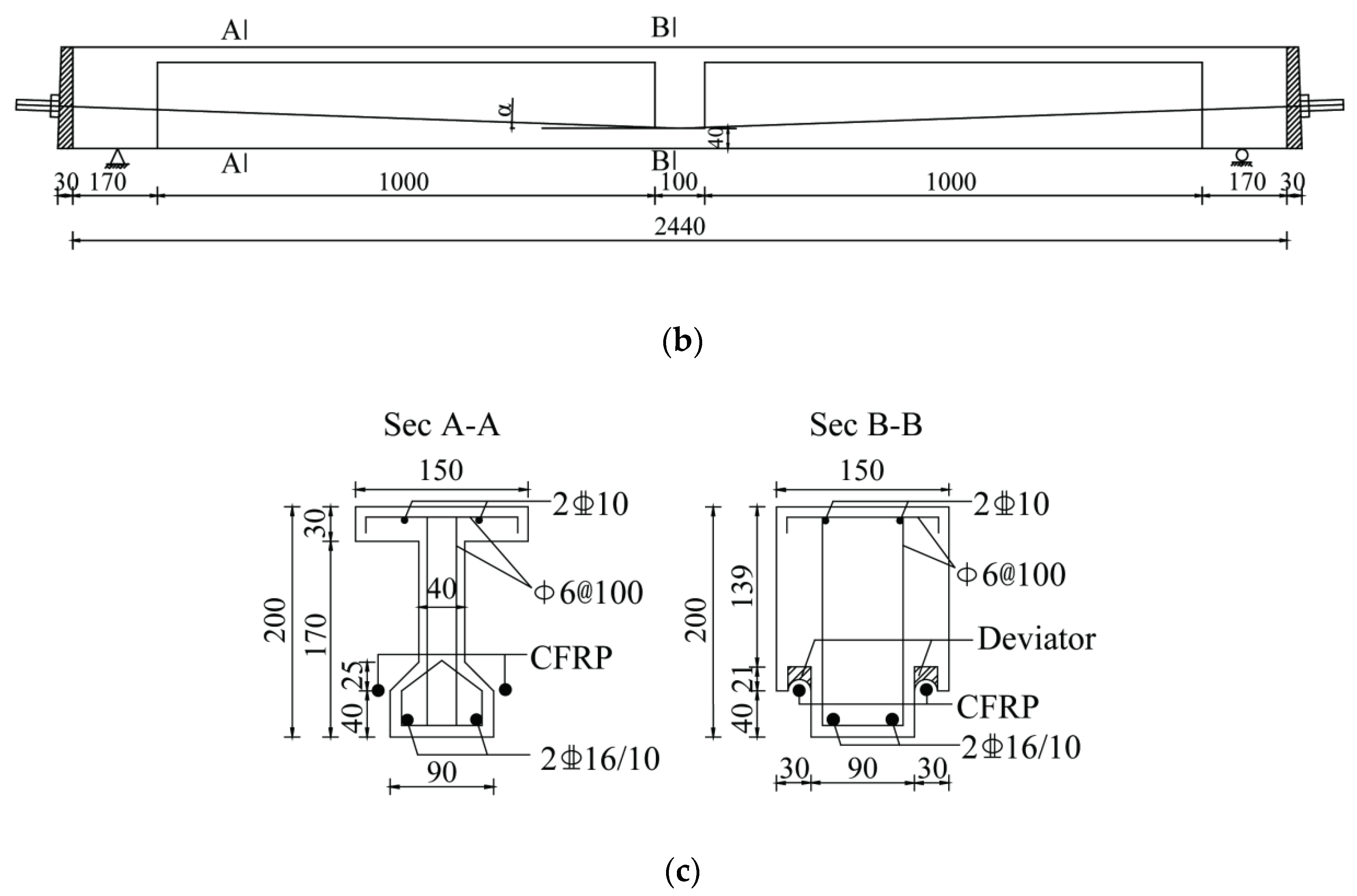
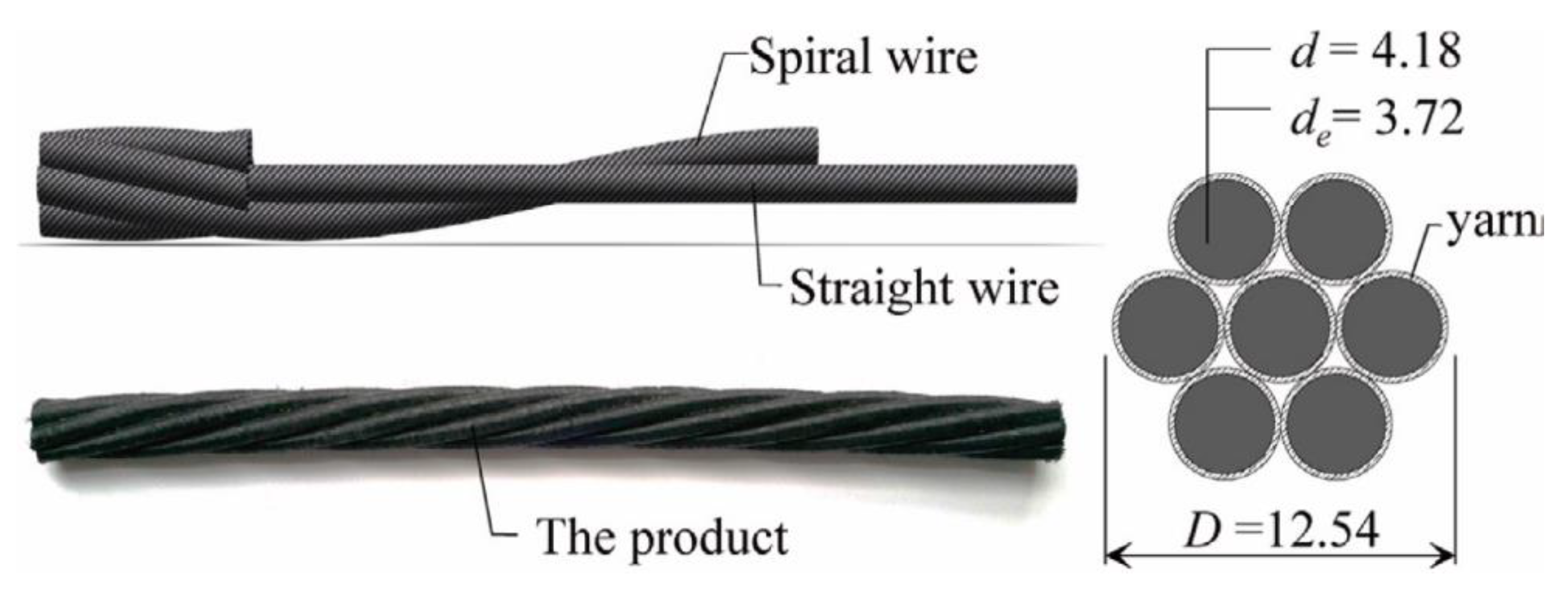
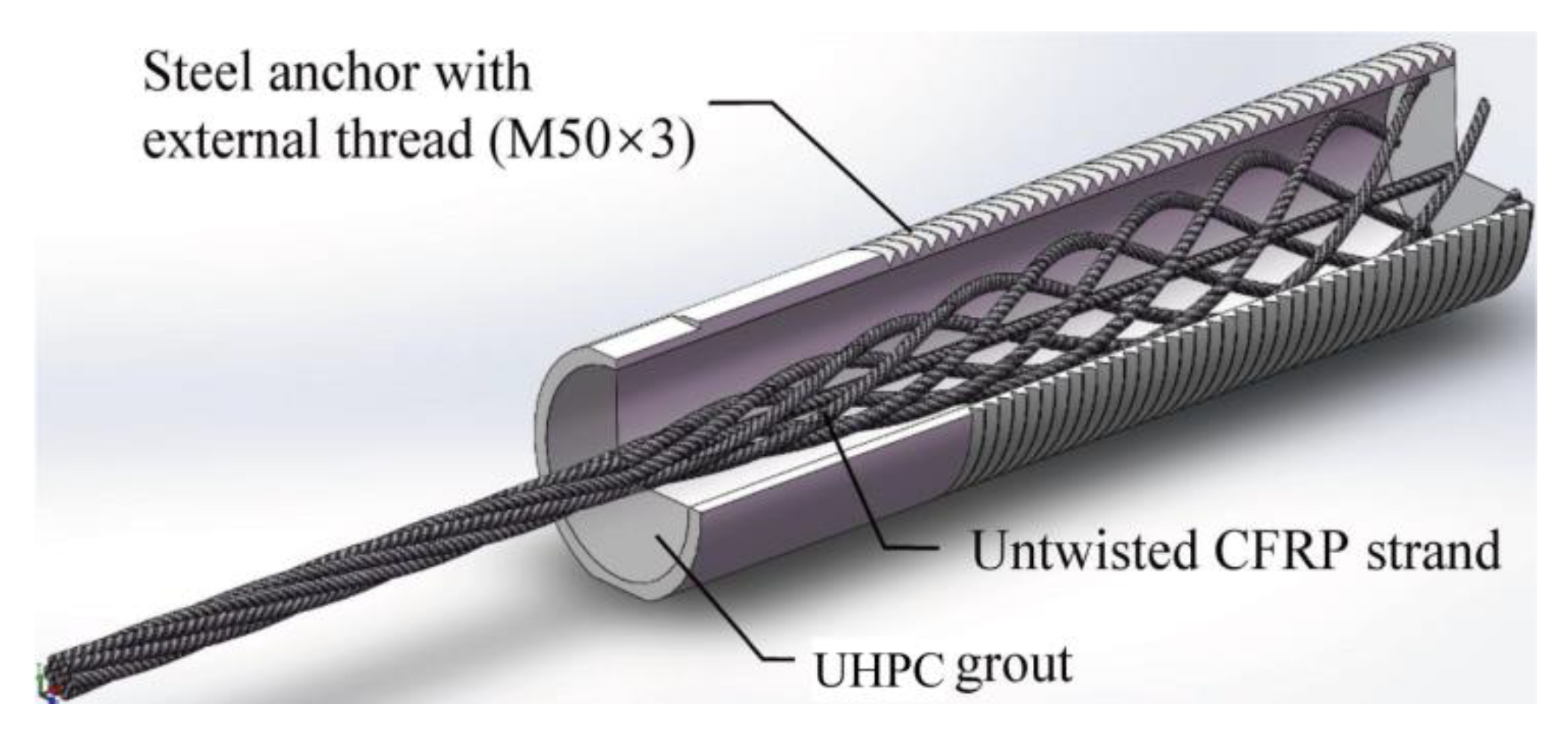
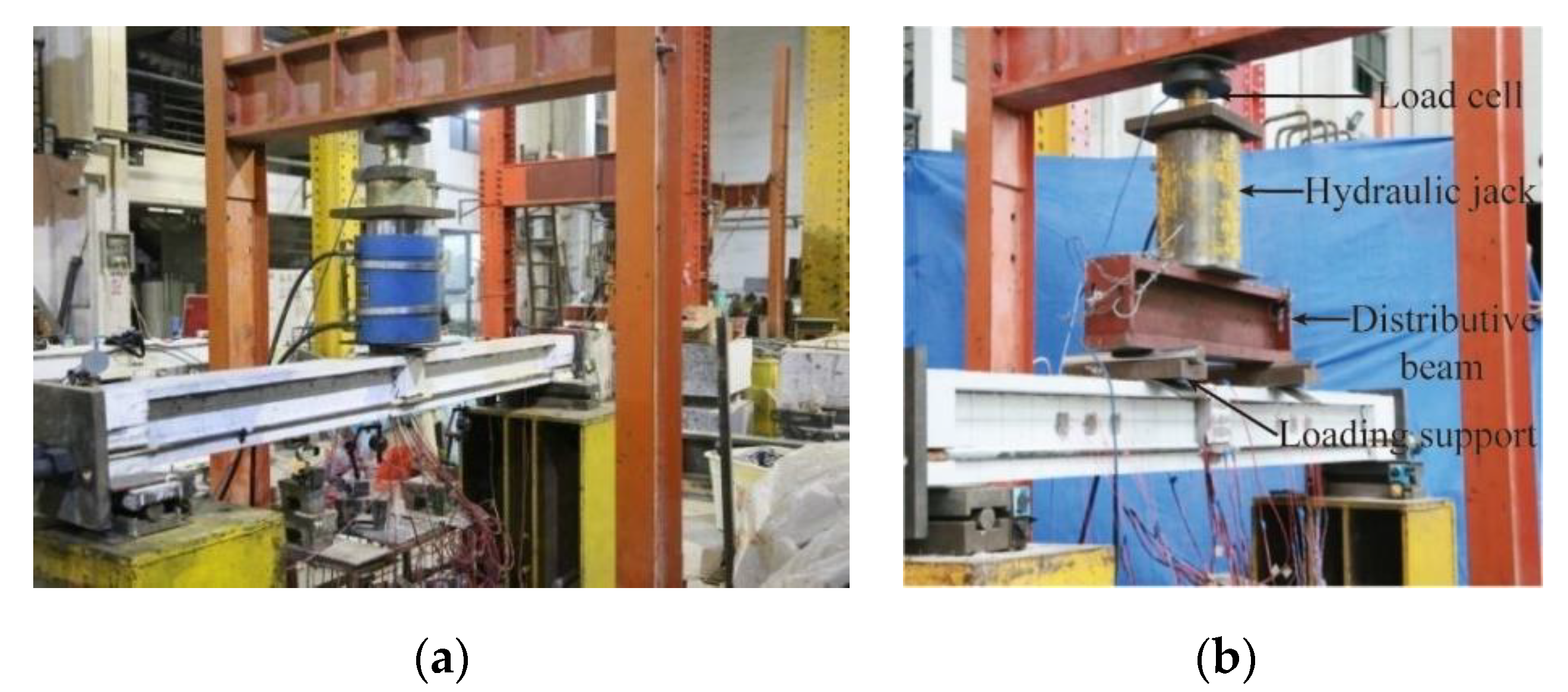
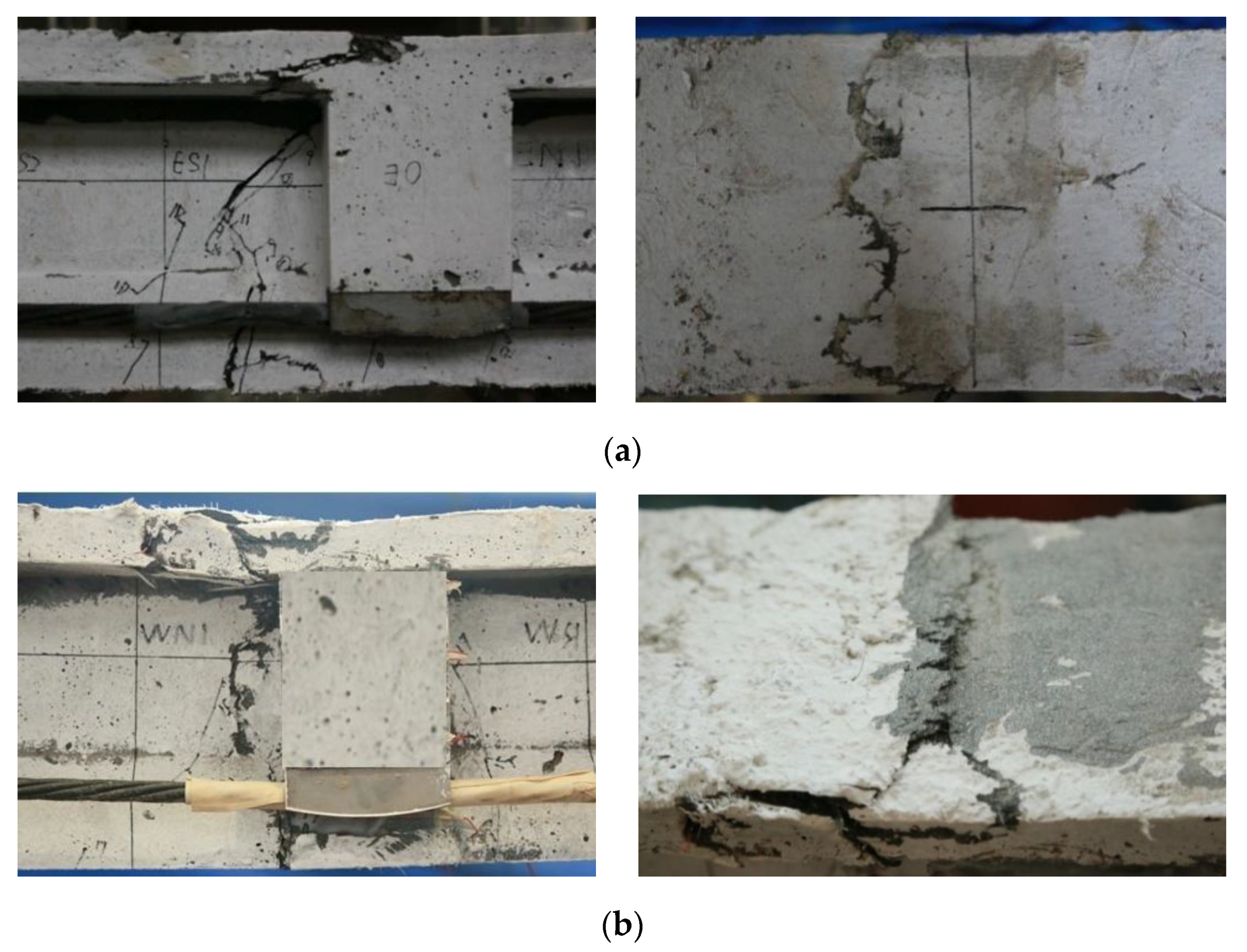
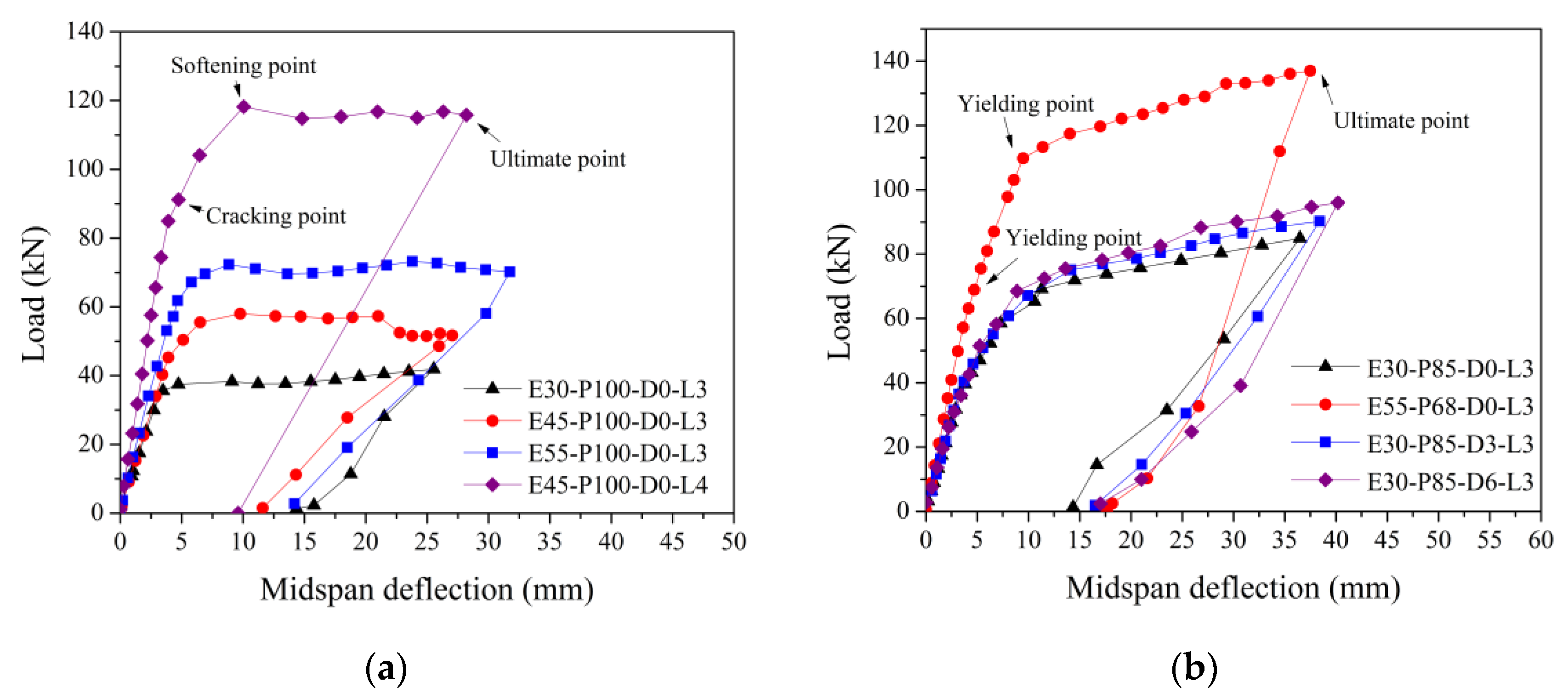
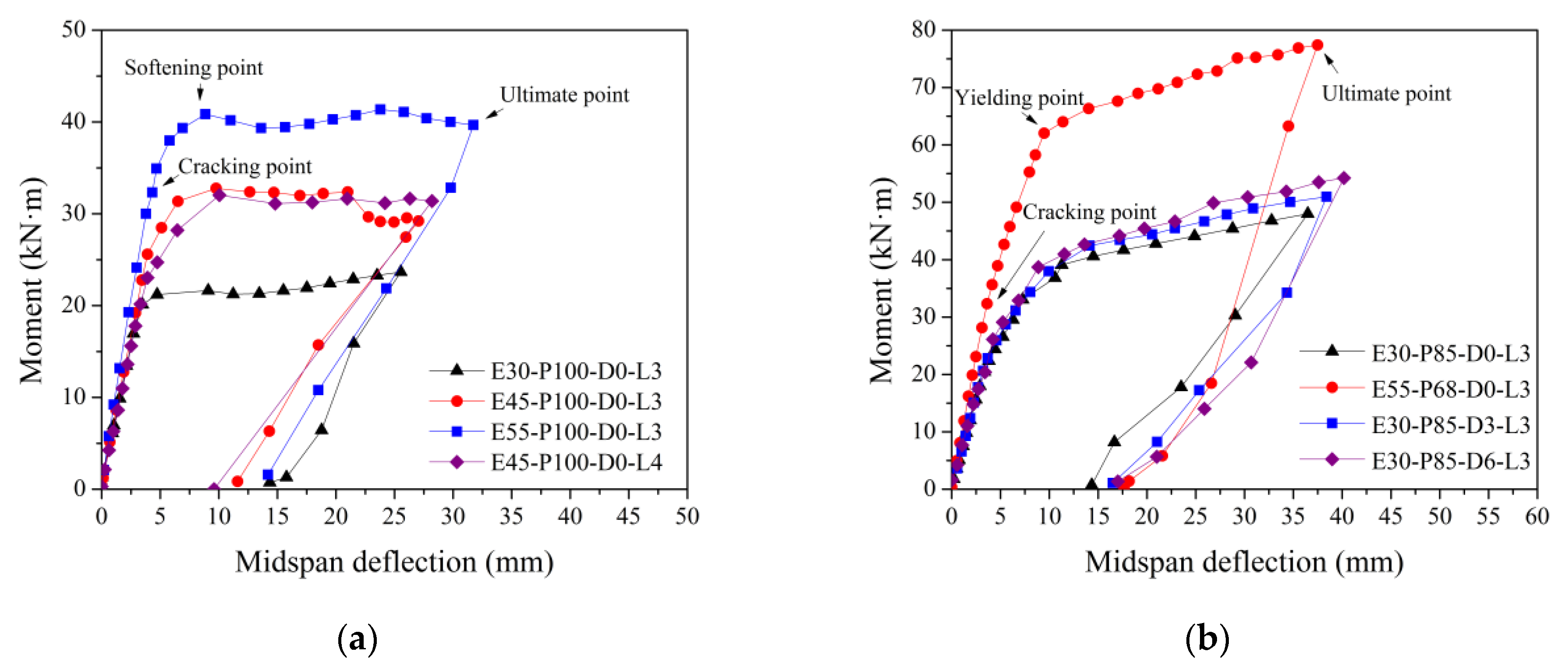

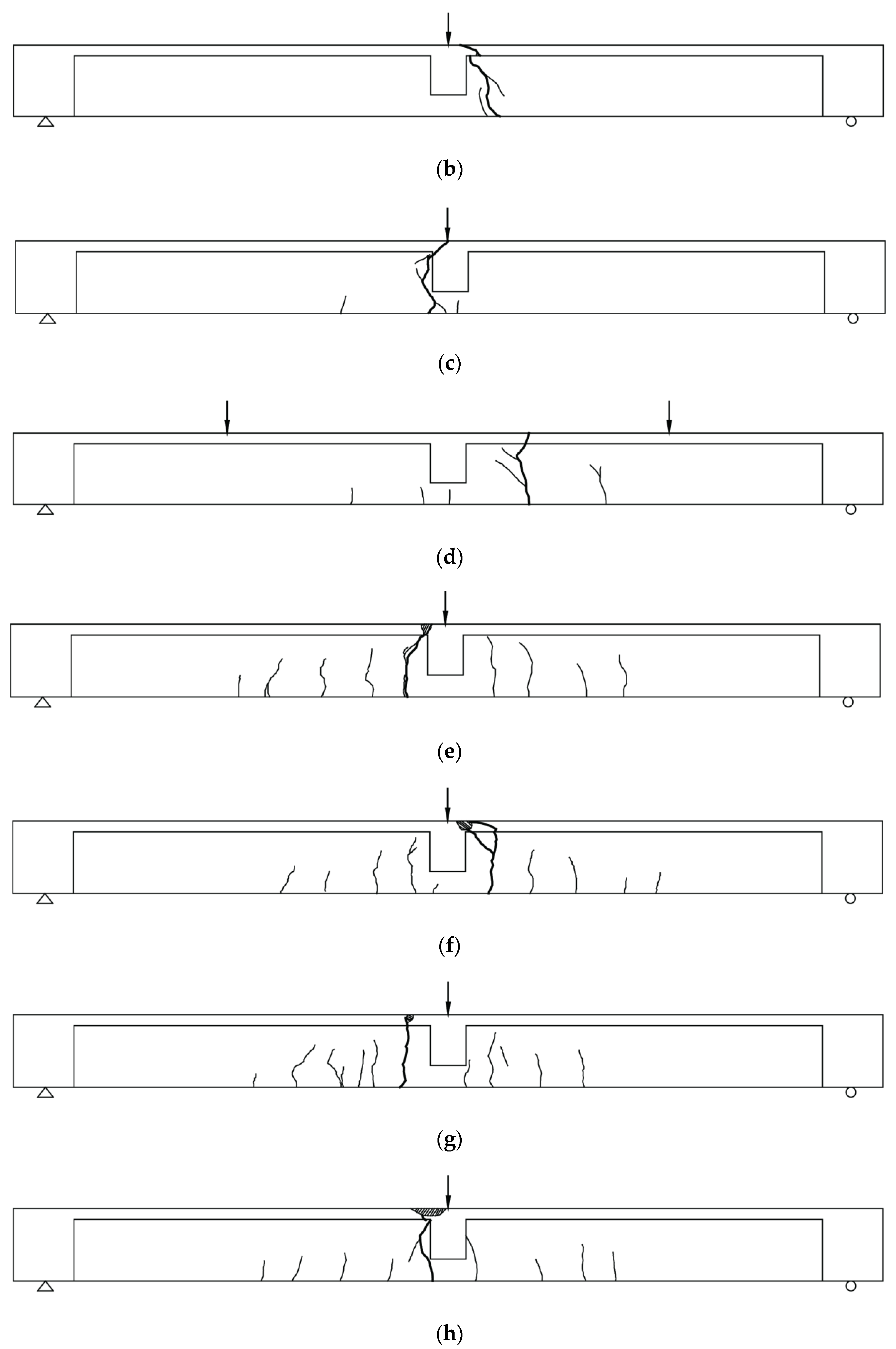
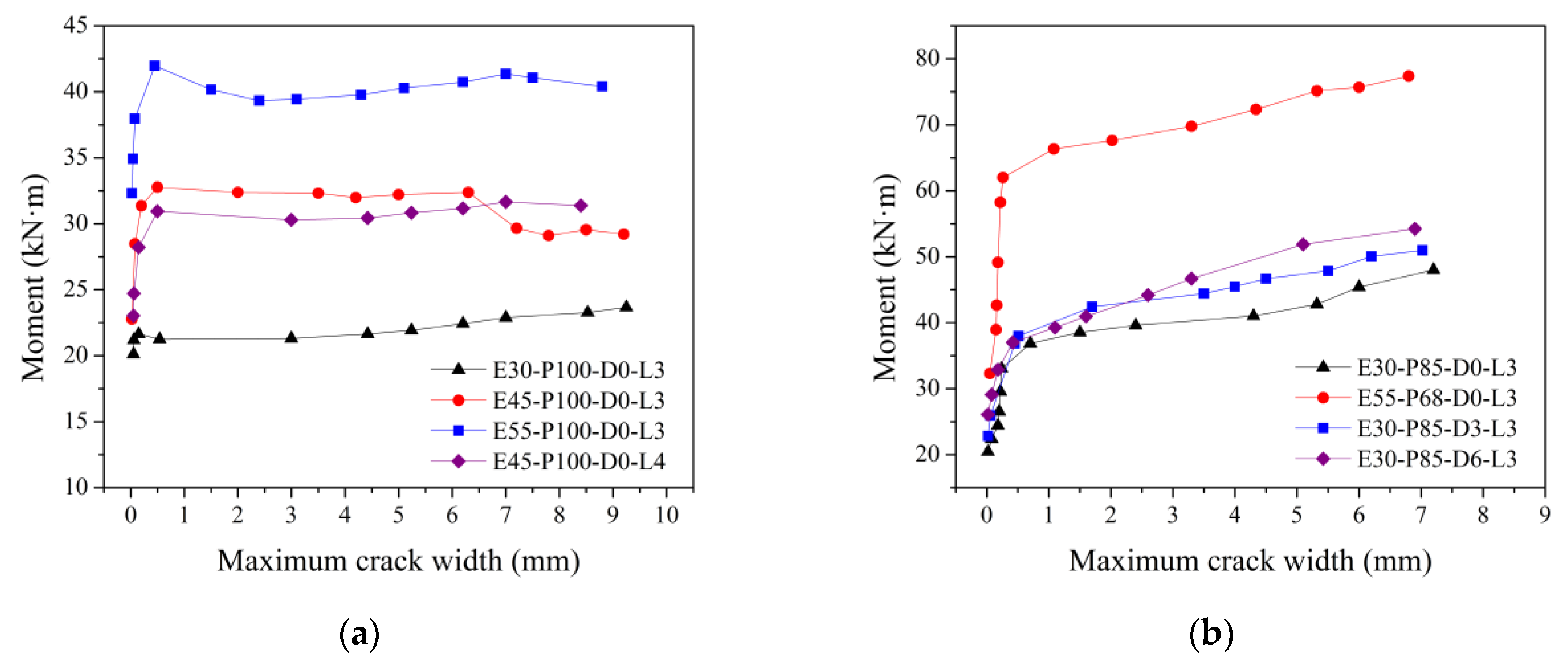


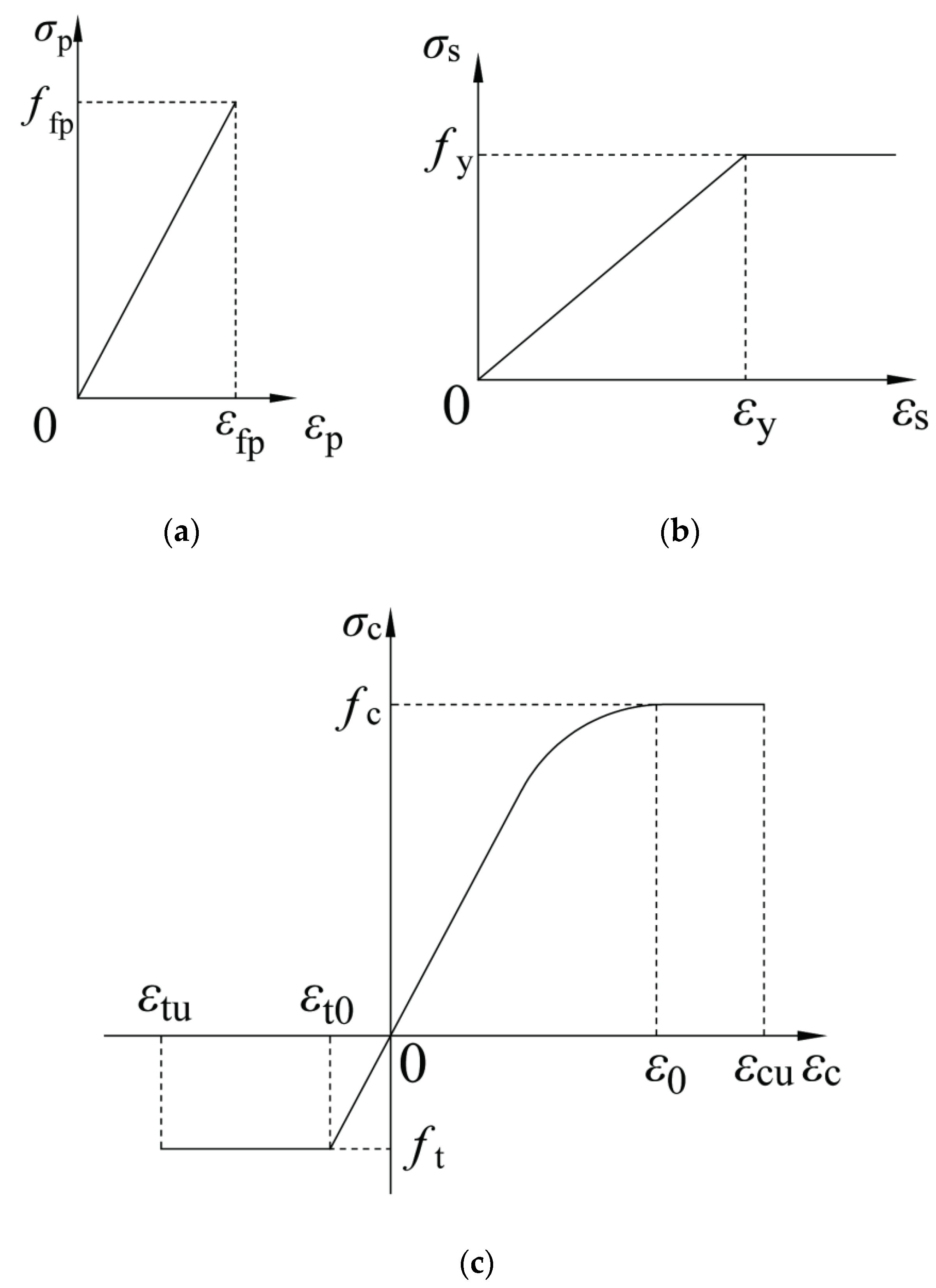

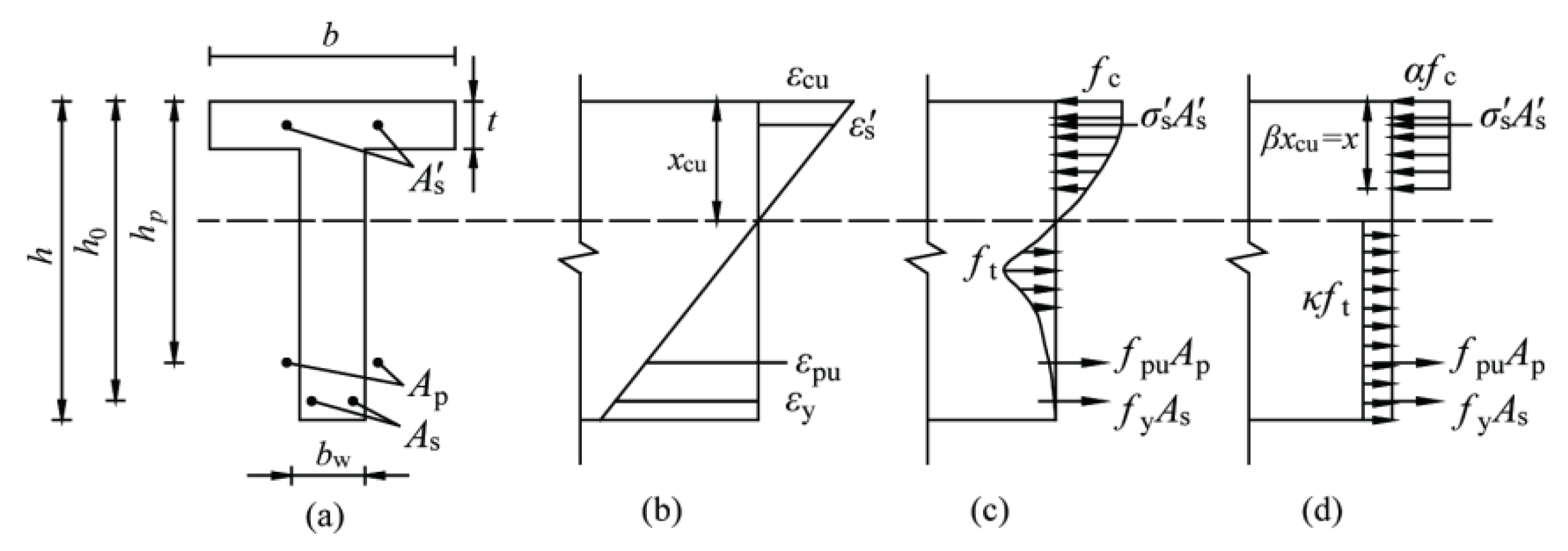
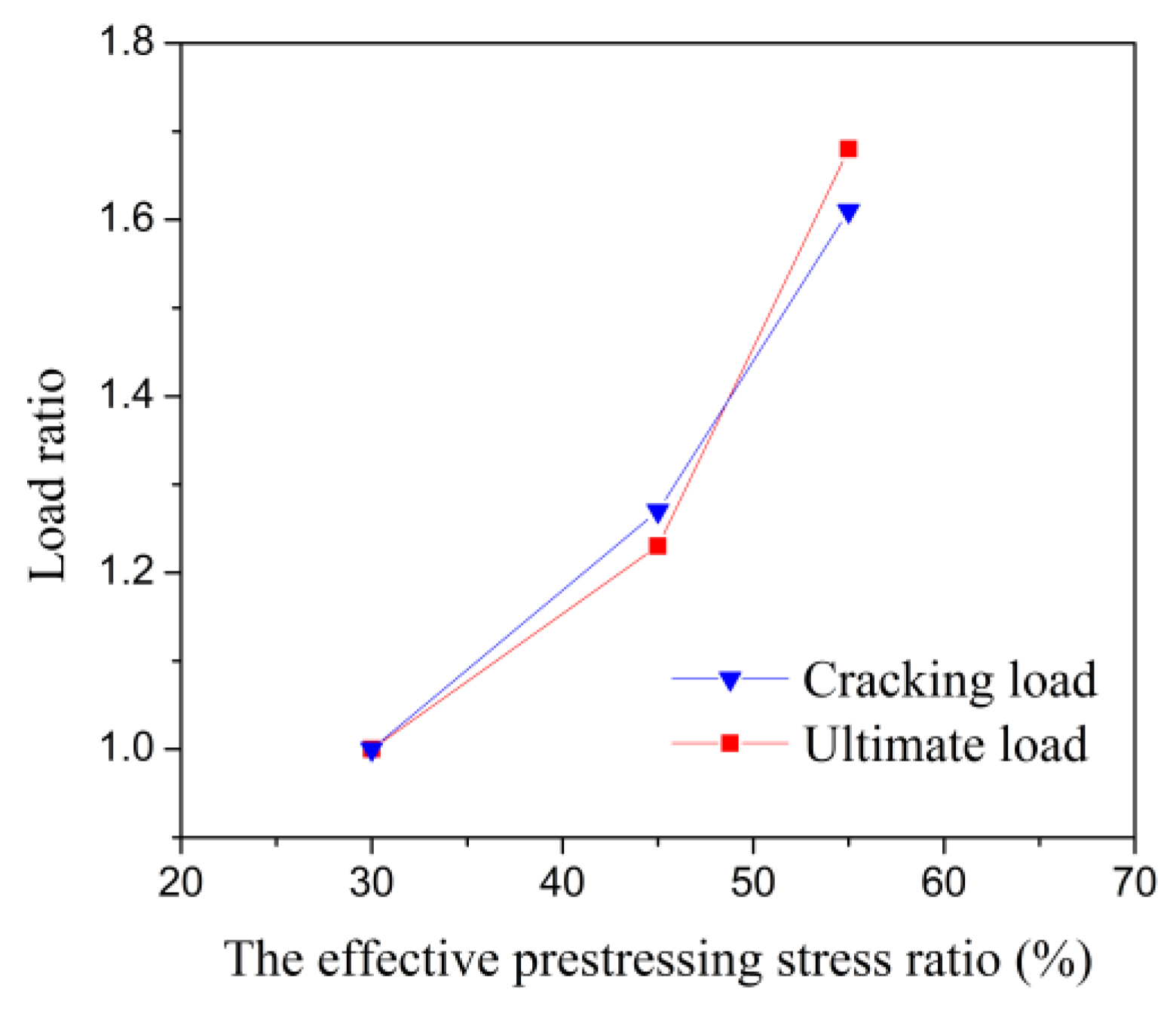
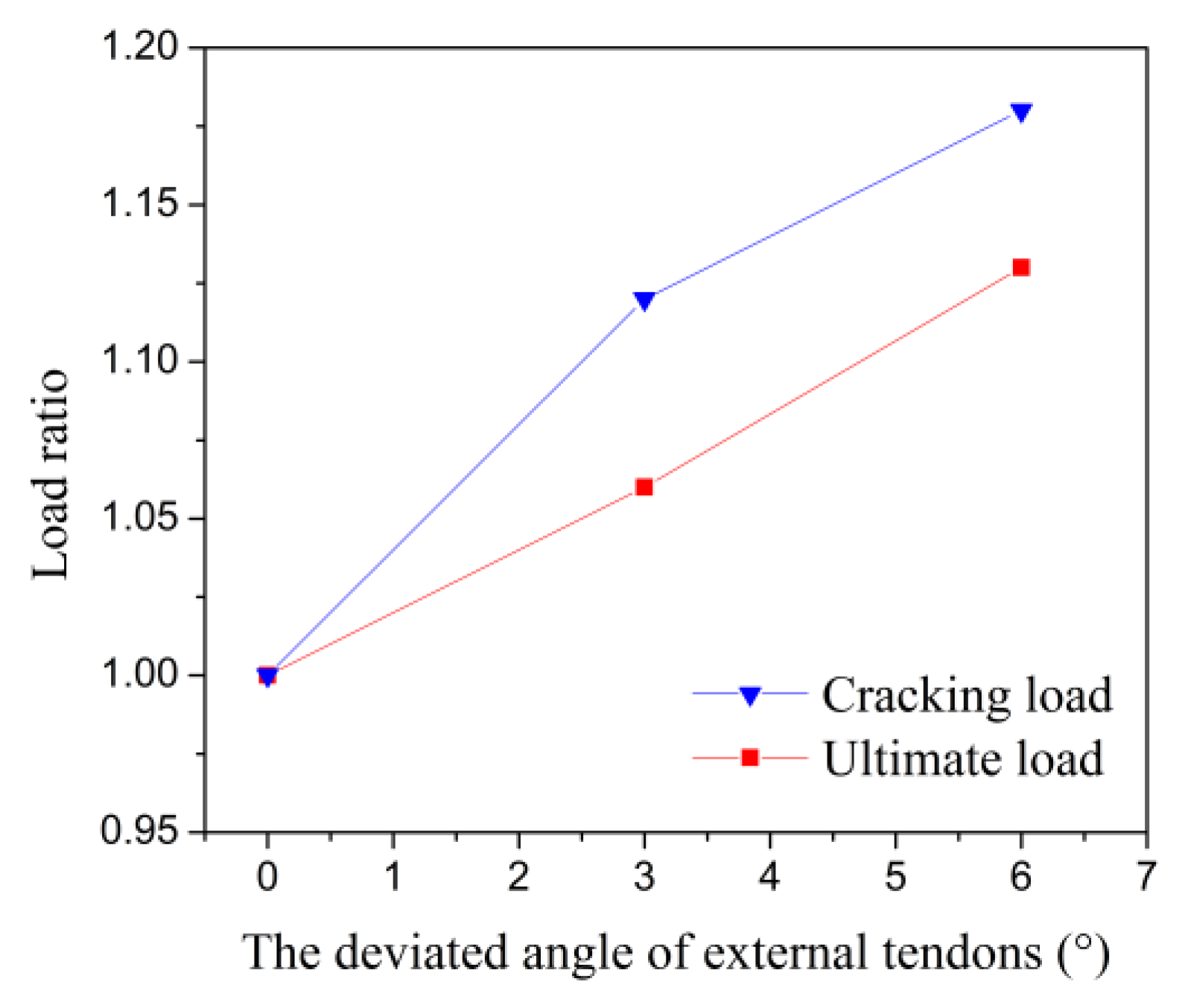
| Specimen Code | Steel Area (mm2) | PPR (%) | fpe (MPa) | αp (°) | Loading Condition | Note | |
|---|---|---|---|---|---|---|---|
| Lower | Upper | ||||||
| E30-P85-D0-L3 | 157 | 157 | 85 | 778.5 | 0 | Three-point | Partially prestressed beams |
| E30-P85-D3-L3 | 157 | 157 | 85 | 786.4 | 3 | Three-point | |
| E30-P85-D6-L3 | 157 | 157 | 85 | 714.3 | 6 | Three-point | |
| E55-P68-D0-L3 * | 402 | 157 | 68 | 1334.9 | 0 | Three-point | |
| E30-P100-D0-L3 | - | - | 100 | 775.8 | 0 | Three-point | Fully prestressed beams |
| E45-P100-D0-L3 * | - | - | 100 | 1023.0 | 0 | Three-point | |
| E45-P100-D0-L4 * | - | - | 100 | 1032.9 | 0 | Four-point | |
| E55-P100-D0-L3 * | - | - | 100 | 1358.6 | 0 | Three-point | |
| Material Type | Nominal Diameter D (mm) | Modulus of Elasticity E (GPa) | Yielding Strength fy (MPa) | Yielding Strain εsy (με) | Tensile Strength ffp (MPa) | Elongation at Ultimate (%) |
|---|---|---|---|---|---|---|
| Steel bar type 1 | 16 | 210 | 451 | 2148 | 593 | 25.6 |
| Steel bar type 2 | 10 | 200 | 447 | 2235 | 581 | 23.3 |
| Steel stirrup | 6 | 200 | 321 | 1605 | 442 | 20.1 |
| CFCC® tendon | 12.54 | 157 | - | - | 2539 | 1.6 |
| Specimen Code | Cracking State | Yielding/Softening State | Ultimate State | Py(Ps)/Pcr | Pu/Pcr | μ | |||
|---|---|---|---|---|---|---|---|---|---|
| Pcr (kN) | Δcr (mm) | Py/Ps (kN) | Δy/Δs (mm) | Pu (kN) | Δu (mm) | ||||
| E30-P85-D0-L3 | 36.2 | 3.36 | 58.5 | 7.28 | 85.0 | 36.48 | 1.62 | 2.35 | 2.48 |
| E30-P85-D3-L3 | 40.4 | 3.70 | 67.2 | 9.95 | 90.2 | 38.40 | 1.66 | 2.23 | 2.52 |
| E30-P85-D6-L3 | 42.6 | 4.23 | 68.5 | 8.89 | 96.0 | 40.19 | 1.61 | 2.25 | 2.51 |
| E55-P68-D0-L3 | 68.9 | 4.72 | 109.8 | 9.47 | 137.0 | 37.48 | 1.59 | 1.99 | 2.57 |
| E30-P100-D0-L3 | 35.6 | 3.48 | 37.5 | 4.74 | 41.9 | 25.54 | 1.05 | 1.18 | 2.01 |
| E45-P100-D0-L3 | 45.3 | 3.91 | 55.5 | 6.51 | 51.7 | 27.05 | 1.23 | 1.14 | 2.10 |
| E45-P100-D0-L4 | 91.2 | 4.75 | 118.2 | 10.06 | 115.8 | 28.21 | 1.30 | 1.27 | 2.01 |
| E55-P100-D0-L3 | 57.2 | 4.32 | 72.6 | 8.86 | 70.2 | 31.73 | 1.27 | 1.23 | 2.08 |
| Specimen Code | Mu,e (kN·m) | Mu,p (kN·m) | Mu,e /Mu,p |
|---|---|---|---|
| E30-P85-D0-L3 | 48.0 | 50.2 | 0.96 |
| E30-P85-D3-L3 | 51.0 | 54.2 | 0.94 |
| E30-P85-D6-L3 | 54.2 | 56.6 | 0.96 |
| E55-P68-D0-L3 | 77.4 | 74.9 | 1.03 |
| Mean | - | - | 0.97 |
| Standard deviation | - | - | 0.03 |
Publisher’s Note: MDPI stays neutral with regard to jurisdictional claims in published maps and institutional affiliations. |
© 2021 by the authors. Licensee MDPI, Basel, Switzerland. This article is an open access article distributed under the terms and conditions of the Creative Commons Attribution (CC BY) license (https://creativecommons.org/licenses/by/4.0/).
Share and Cite
Jia, L.; Fang, Z.; Huang, Z.; Pilakoutas, K.; Wang, Q.; Tan, X. Flexural Behavior of UHPC Beams Prestressed with External CFRP Tendons. Appl. Sci. 2021, 11, 9189. https://doi.org/10.3390/app11199189
Jia L, Fang Z, Huang Z, Pilakoutas K, Wang Q, Tan X. Flexural Behavior of UHPC Beams Prestressed with External CFRP Tendons. Applied Sciences. 2021; 11(19):9189. https://doi.org/10.3390/app11199189
Chicago/Turabian StyleJia, Li, Zhi Fang, Zhengmeng Huang, Kypros Pilakoutas, Qiwu Wang, and Xingyu Tan. 2021. "Flexural Behavior of UHPC Beams Prestressed with External CFRP Tendons" Applied Sciences 11, no. 19: 9189. https://doi.org/10.3390/app11199189






